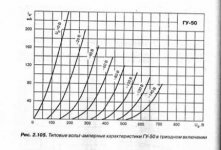I have some questions about using GU-50 in triode connection. I've heard that I should not exceed 400V by much. What disadvantages would using higher voltage cause? I'm asking because I have a spare transformer and few GU-50s that I would like to use to build an A class.
Last edited:
Tried search and found several that mention 400V being reasonable but couldn't find an answer if 520V is still acceptable and what the disadvantages would be.
could thermal run away be the issue with higher voltage ?
or voltage is also relative ... ?
did you say classA ?
I suppose that means SE ?
don't know if anyone use it in SE ?
but in classA, is voltage not lower than AB ?
or voltage is also relative ... ?
did you say classA ?
I suppose that means SE ?
don't know if anyone use it in SE ?
but in classA, is voltage not lower than AB ?
I think Anatoliy aka Wavebourn is the right person to ask...
yes, he made a pp amp with 800 volts plate, look for the Pyramid amps.....http://www.diyaudio.com/forums/tubes-valves/224306-pyramid-ix-monoblock-200w-4x-gu-50-a.html
Yep, but it was in pentode mode.yes, he made a pp amp with 800 volts plate, look for the Pyramid amps.....http://www.diyaudio.com/forums/tubes-valves/224306-pyramid-ix-monoblock-200w-4x-gu-50-a.html
wavebourn is the GU-50 expert, if he doesn't chime in here you may want to PM him. You can also find more info at his site.
I was considering building a pair of pyramids myself but I don't have the time and money right now. Maybe if he releases some PCBs I will be able to find some extra time and money.
I was considering building a pair of pyramids myself but I don't have the time and money right now. Maybe if he releases some PCBs I will be able to find some extra time and money.
wavebourn is the GU-50 expert ...
and maybe also hard to follow
btw, was this 200watt amp finished, or did he have second thoughts about publishing it ?
Tying G2 + G3 + plate helps with high voltages, if G3 is tied to cathode there is a risk of G2-G3 arc-over around the pin connections inside.
The classical answer is to find the max voltage for the screen grid and make that the max plate+screen voltage allowed in triode mode. So if the max screen grid voltage is shown as 400V on the GU50 data sheet, then that would be the 'safe' choice as max allowable plate voltage in triode mode.
In practice, you can probably go higher than that. But then you're into the realm of knowledge gained by practical experience, of which I have none (with GU50). I'm hoping to rectify that soon.
--
In practice, you can probably go higher than that. But then you're into the realm of knowledge gained by practical experience, of which I have none (with GU50). I'm hoping to rectify that soon.
--
The classical answer is to find the max voltage for the screen grid and make that the max plate+screen voltage allowed in triode mode. So if the max screen grid voltage is shown as 400V on the GU50 data sheet, then that would be the 'safe' choice as max allowable plate voltage in triode mode.
In practice, you can probably go higher than that. But then you're into the realm of knowledge gained by practical experience, of which I have none (with GU50). I'm hoping to rectify that soon.
--
The max screen grid voltage of GU-50 according to data sheet is 250V.
Attachments
Last edited:
The max screen grid voltage of GU-50 according to data sheet is 250V.
Oh, that does make things difficult. Power out will be limited. Maybe it could stand 300V plate+screen grid?
Well, at least the tubes are cheap. The sockets are kind of pricey, though.
What would happen with Ea+g2 = 300V, Eg = -40V, Ia = 90mA? That would run each GU-50 at Pa+g2 = 27W. Should be able to get at least 10W per channel out of a push-pull pair, right?
--
Last edited:
The max screen grid voltage of GU-50 according to data sheet is 250V.
I've been told that 300V on Ua+Ug2 (triode connected) is OK.
Here's some more info:
GU 50 (LS 50)
Röhren-Verstärker mit der LS 50 (GU 50)
Herstellung von Röhrenfassungen, hier am Beispiel der LS 50 - GU 50
Last edited:
The max screen grid voltage of GU-50 according to data sheet is 250V.
The GU50 and the FL152 are basically the same tube (same data but different Glass and Pins)
In standard triode mode (G3 connected to cathode, G2 to plate) the max idle voltage allowed is 400V, see page 10 of the attachement.
Attachments
The max screen grid voltage of GU-50 according to data sheet is 250V.
That's in pentode connexion and at high frequency.
Triode strapped and at audio frequencies, it takes 500v without problems!
Oh, that does make things difficult. Power out will be limited. Maybe it could stand 300V plate+screen grid?
Well, at least the tubes are cheap. The sockets are kind of pricey, though.
What would happen with Ea+g2 = 300V, Eg = -40V, Ia = 90mA? That would run each GU-50 at Pa+g2 = 27W. Should be able to get at least 10W per channel out of a push-pull pair, right?
--
Something like this...
What would happen with Ea+g2 = 300V, Eg = -40V, Ia = 90mA? That would run each GU-50 at Pa+g2 = 27W.
Output power will be no more than 8...9 W.
- Home
- Amplifiers
- Tubes / Valves
- GU-50 triode


